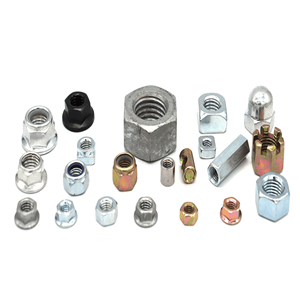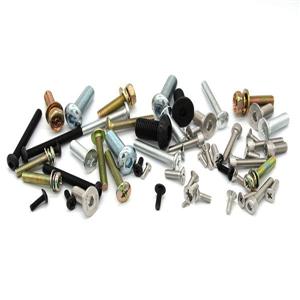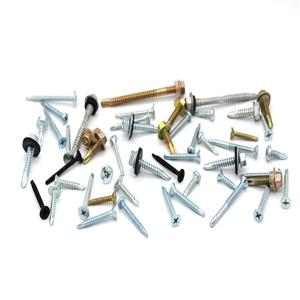Surface treatment of fasteners: Which one should we choose?
Almost all commercial fasteners are made of carbon steel and alloy steel, and generally have anti-corrosion requirements. Therefore, the surface-treated plating must be firmly attached and cannot fall off during installation and removal. On the other hand, for threaded fasteners, the plating needs to be thin enough so that the threads can still be screwed after plating. Generally, the temperature limit of the coating is lower than that of the fastener material, so the operating temperature requirements of the fastener must also be considered.
The main purpose of surface treatment is aesthetics and corrosion protection. Because the main function of the fastener is to fasten parts, and the surface treatment also has a great impact on its fastening performance. Therefore, when selecting the surface treatment process, factors such as the torque and consistency of the pre-tightening force of the fastener must be considered.
A high-level designer must not only consider the structural design and manufacturing process, but also pay attention to the technical requirements of assembly, and even environmental and economic requirements. The following briefly introduces some commonly used coatings for fasteners based on the above factors for reference by fastener practitioners.
Galvanized
Electro-galvanized is the most commonly used coating for commercial fasteners. It is cheaper and looks better. It can be black or army green. However, its anticorrosive performance is average, and its anticorrosive performance is the lowest among zinc plating (coating) layers. Generally, the neutral salt spray test of electrogalvanizing is within 72 hours, and a special sealant is also used to make the neutral salt spray test more than 200 hours, but the price is expensive, which is 5-8 times that of general galvanizing.
The process of galvanizing is prone to hydrogen embrittlement, so bolts above 10.9 grade are generally not treated with galvanizing. Although the oven can be used to remove hydrogen after plating, but the passivation film will be damaged when the temperature is above 60 ℃, so the hydrogen removal must It is performed before passivation after plating. This has poor operability and high processing costs. In reality, the general production plant will not take the initiative to remove hydrogen unless mandated by a specific customer.
Electrogalvanized fasteners have poor torque-pretension consistency and are unstable, and are generally not used for connection of important parts. In order to improve the torque-pretension uniformity, the method of applying lubricating material after plating can also be used to improve and increase the torque-pretension uniformity.
Phosphating
A basic principle is that phosphating is cheaper than galvanizing and has lower corrosion resistance than galvanizing. After phosphating, it should be oiled. The corrosion resistance has a great relationship with the performance of the oil. For example, after phosphate coating with general antirust oil, the neutral salt spray test is only 10-20 hours. Coated with high-grade antirust oil, it can reach 72 ~ 96 hours. But its price is two to three times that of ordinary phosphating oil.
Two types of fastener phosphating are commonly used, zinc phosphating and manganese phosphating. Zinc phosphating has better lubrication performance than manganese phosphating. Manganese phosphating has better corrosion resistance and better wear resistance than zinc plating. Its operating temperature can reach 225 degrees to 400 degrees Fahrenheit (107 ~ 204 ℃). Especially the connection of some important parts. For example, engine connecting rod bolts, nuts, cylinder heads, main bearings, flywheel bolts, wheel bolt nuts, etc.
High-strength bolts are phosphated to avoid hydrogen embrittlement. Therefore, bolts above 10.9 in the industrial field generally use phosphated surface treatment.
Oxidation (blackening)
Blackening + oiling is a popular plating for industrial fasteners because it is the cheapest and looks good until the oil is depleted. Because it is blackened and has almost no rust resistance, it will rust quickly without oil. Even in the presence of oil, the neutral salt spray test can only reach 3 to 5 hours.
Electroplated cadmium
The corrosion resistance of the cadmium coating is very good, especially in the marine atmospheric environment, the corrosion resistance is better than other surface treatments. The waste liquid treatment process in the process of electroplating cadmium is expensive and costly, and its price is about 15-20 times that of electroplating zinc. So it is not used in the general industry, but only for some specific environments. For example, fasteners for oil drilling platforms and HNA aircraft.
Chrome plating
The chromium plating layer is very stable in the atmosphere, is not easy to discolor and lose gloss, and has high hardness and good wear resistance. Chrome plating on fasteners is generally used as a decorative feature. It is rarely used in industrial fields with high requirements on corrosion resistance, because good chromium plated fasteners are just as expensive as stainless steel, and only use stainless steel when the strength of stainless steel is insufficient.
To prevent corrosion, copper and nickel should be plated before chrome plating. The chromium coating can withstand high temperatures of 1200 ° F (650 ° C). But it also has the problem of hydrogen embrittlement like electroplated zinc.
Nickel plated
A method of plating a layer of nickel on a metal or some non-metals by electrolytic or chemical methods is called nickel plating. Nickel plating is divided into electroplated nickel and electroless nickel plating.
It is mainly used in places where both anticorrosion and good conductivity are required. Such as the lead-out terminal of the vehicle battery.
Hot-dip zinc
Hot dip galvanizing is a thermal diffusion coating where zinc is heated to a liquid. Its coating thickness is 15 ~ 100μm, and it is not easy to control, but it has good corrosion resistance and is mostly used in engineering. Pollution is severe during hot-dip zinc processing, including zinc waste and zinc steam.
Due to the thick plating layer, the problem that the internal and external threads are difficult to screw in is caused in the fastener. Due to the temperature of hot dip zinc processing (340-500C), it cannot be used for fasteners above 10.9.
Zincizing
Zinc is a solid metallurgical thermal diffusion coating of zinc powder. Its uniformity is good, and a uniform layer can be obtained in the thread and the blind hole. The thickness of the coating is 10 to 110 μm, and the error can be controlled at 10%. Its bonding strength and corrosion resistance with the substrate are the best among zinc coatings (galvanized, hot-dip galvanized, Dacromet). Its processing is pollution-free and the most environmentally friendly.
Dacro
Dacromet is a transliteration and abbreviation of DACROMET, referred to as Dacromet, Dacrorust, Dickron. It is named as zinc-chromium coating in China, and it is a new type of anticorrosive coating with zinc powder, aluminum powder, chromic acid and deionized water as main ingredients.
There is no hydrogen embrittlement, and the torque-pretension force is consistent. If valence chrome and environmental protection are not considered, it is actually most suitable for high-strength fasteners with high corrosion resistance requirements.




